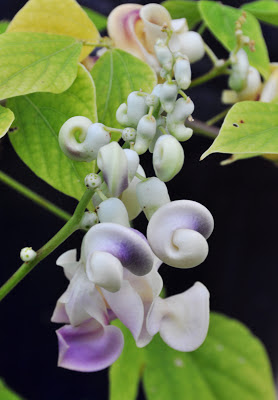Here is a Colchicum, the variety being lost in time, that started blooming in early September. While I haven't been timely in getting the picture here, I still enjoy seeing it. There are two clumps under the 'Little Gem' Magnolia, which don't get very much sun, but still hold their own in providing a few weeks of color in a spot where not much else is growing. You can see some of the magnolia leaves that were dropping in the late summer around the base of the clusters. I don't have a lot of good spots for these at this time, but I expect there will be more places as the other trees get larger.
Here is my Lycoris Radiata, from the Plant Delights Nursery. The end of September was the first time it has bloomed underneath the Paperbark Maple tree, in its second year. This is a very good spot since it still gets lots of light and sun on the leaves, which are now up. There were only leaves last fall, but they collected enough energy that there are two flowering stalks.
I planted three other Lycoris around the base of the standard/grafted dwarf cedar in the labyrinth. I have wondered why they weren't doing anything. Then last weekend I saw the leaves above the ground on one, but they were heavily chewed by one of my critters. David blamed the deer, but the teeth marks were too small for one of those long-legged rodents. I am guessing either a rabbit or groundhog, with my money on a rabbit. We only see rabbits occasionally, but they also cover a wider range of area. The groundhogs stay much closer to the edges since they move slower. The maple tree is closer to the house and road, so it doesn't get the rabbits. I need to move any that appear this fall to give them a chance.
Then there is the Oxblood Lily, Rhodophiala bifida, in the labyrinth. Another selection for Plant Delights, and again, this is its second year. I keep a metal stake next to this, as well as the other fall blooming bulbs, since it is easy to forget their location.
This resides in what I call the back turn of the labyrinth, close to other plants that are distinctly red or orange in color. In the background you can see a type of perennial foxglove which I am trying to verify the proper name. Again, since this picture was taken in late September, there is a large cluster of leaves that have emerged, and will continue until late spring, building up the bulb for next year. At about twelve inches high, I really like this since it appears when the rest of the garden seems to be dying around it. I hope there will be a nice large clump in a few years, especially since it appears to be unattractive to the chewing rodents who claim this territory as their own. I guess I can't blame them, but it gets expensive to feed them such exotic meals.
Finally, though I must quickly admit that is is not a bulb, I wanted to show the blooms of the Vigna caracalla, or Snail Flower. David and I first saw this in Thomas Jefferson's vegetable garden at Monticello. There were six foot high teepee poles with monstrous piles of vine and flowers in the late summer. It is not a perennial, so this year it lives in a big pot, which we put beside the front porch. When we originally planted it on the former bamboo fence and stick trellis, it was severely eaten by the deer, who also seem to love the fragrant flowers.
It struggled through the summer, even though there was lots of sun. David has read it is a very heavy feeder. Since it is kept in the pot so we can move it inside when the weather gets cold, it needs to be heavily fertilized, which did not happen this summer. These were the biggest flowers to be found. We hope to do better next year, but we also need to find a safe place away from the deer.






